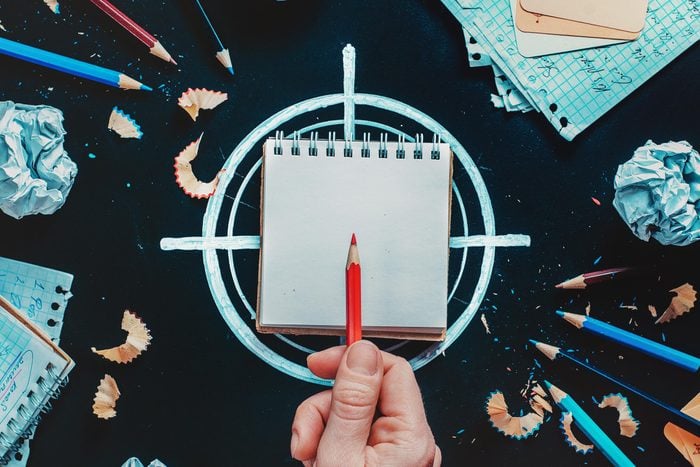One Teacher’s Brilliant Strategy to Stop Future School Shootings
Updated: Mar. 27, 2023

Here's how one schoolteacher takes time each week to identify and look out for the lonely kids.
Editor’s note: This essay originally appeared in a 2014 issue of Reader’s Digest, and millions shared the online version in 2018 after the school shooting in Parkland, Florida. Sadly, this issue will continue to be relevant until America revisits its gun laws.
A few weeks ago, I went into my son Chase’s class for tutoring. I’d emailed Chase’s teacher one evening and said, “Chase keeps telling me that this stuff you’re sending home is math—but I’m not sure I believe him. Help, please.” She emailed right back and said, “No problem! I can tutor Chase after school anytime.” And I said, “No, not him. Me. He gets it. Help me.”
And that’s how I ended up standing at a chalkboard in an empty fifth-grade classroom while Chase’s teacher sat behind me, using a soothing voice to try to help me understand the “new way we teach long division.” Luckily for me, I didn’t have to unlearn much because I’d never really understood the “old way we taught long division.” It took me a solid hour to complete one problem, but I could tell that Chase’s teacher liked me anyway. She used to work with NASA, so obviously we have a whole lot in common.
Afterward, we sat for a few minutes and talked about teaching children and what a sacred trust and responsibility it is. We agreed that subjects like math and reading are not the most important things that are learned in a classroom. We talked about shaping little hearts to become contributors to a larger community—and we discussed our mutual dream that those communities might be made up of individuals who are kind and brave above all.
And then she told me this.
Every Friday afternoon, she asks her students to take out a piece of paper and write down the names of four children with whom they’d like to sit the following week. The children know that these requests may or may not be honored. She also asks the students to nominate one student who they believe has been an exceptional classroom citizen that week. All ballots are privately submitted to her.
And every single Friday afternoon, after the students go home, she takes out those slips of paper, places them in front of her, and studies them. She looks for patterns.
Who is not getting requested by anyone else?
Who can’t think of anyone to request?
Who never gets noticed enough to be nominated?
Who had a million friends last week and none this week?
You see, Chase’s teacher is not looking for a new seating chart or “exceptional citizens.” Chase’s teacher is looking for lonely children. She’s looking for children who are struggling to connect with other children. She’s identifying the little ones who are falling through the cracks of the class’s social life. She is discovering whose gifts are going unnoticed by their peers. And she’s pinning down—right away—who’s being bullied and who is doing the bullying.
As a teacher, parent, and lover of all children, I think this is the most brilliant Love Ninja strategy I have ever encountered. It’s like taking an X-ray of a classroom to see beneath the surface of things and into the hearts of students. It is like mining for gold—the gold being those children who need a little help, who need adults to step in and teach them how to make friends, how to ask others to play, how to join a group, or how to share their gifts. And it’s a bully deterrent because every teacher knows that bullying usually happens outside her eyeshot and that often kids being bullied are too intimidated to share. But, as she said, the truth comes out on those safe, private, little sheets of paper.
As Chase’s teacher explained this simple, ingenious idea, I stared at her with my mouth hanging open. “How long have you been using this system?” I said.
Ever since Columbine, she said. Every single Friday afternoon since Columbine. Good Lord.
This brilliant woman watched Columbine knowing that all violence begins with disconnection. All outward violence begins as inner loneliness. Who are our next mass shooters and how do we stop them? She watched that tragedy knowing that children who aren’t being noticed may eventually resort to being noticed by any means necessary.
And so she decided to start fighting violence early and often in the world within her reach. What Chase’s teacher is doing when she sits in her empty classroom studying those lists written with shaky 11-year-old hands is saving lives. I am convinced of it.
And what this mathematician has learned while using this system is something she really already knew: that everything—even love, even belonging—has a pattern to it. She finds the patterns, and through those lists she breaks the codes of disconnection. Then she gets lonely kids the help they need. It’s math to her. It’s math.
All is love—even math. Amazing.
What a way to spend a life: looking for patterns of love and loneliness. Stepping in, every single day, and altering the trajectory of our world.
The facts about mass shootings in America are undeniable. Do your part to decrease loneliness, whenever you can.
Sources:
- momastery.com: “Share This with All the Schools, Please”